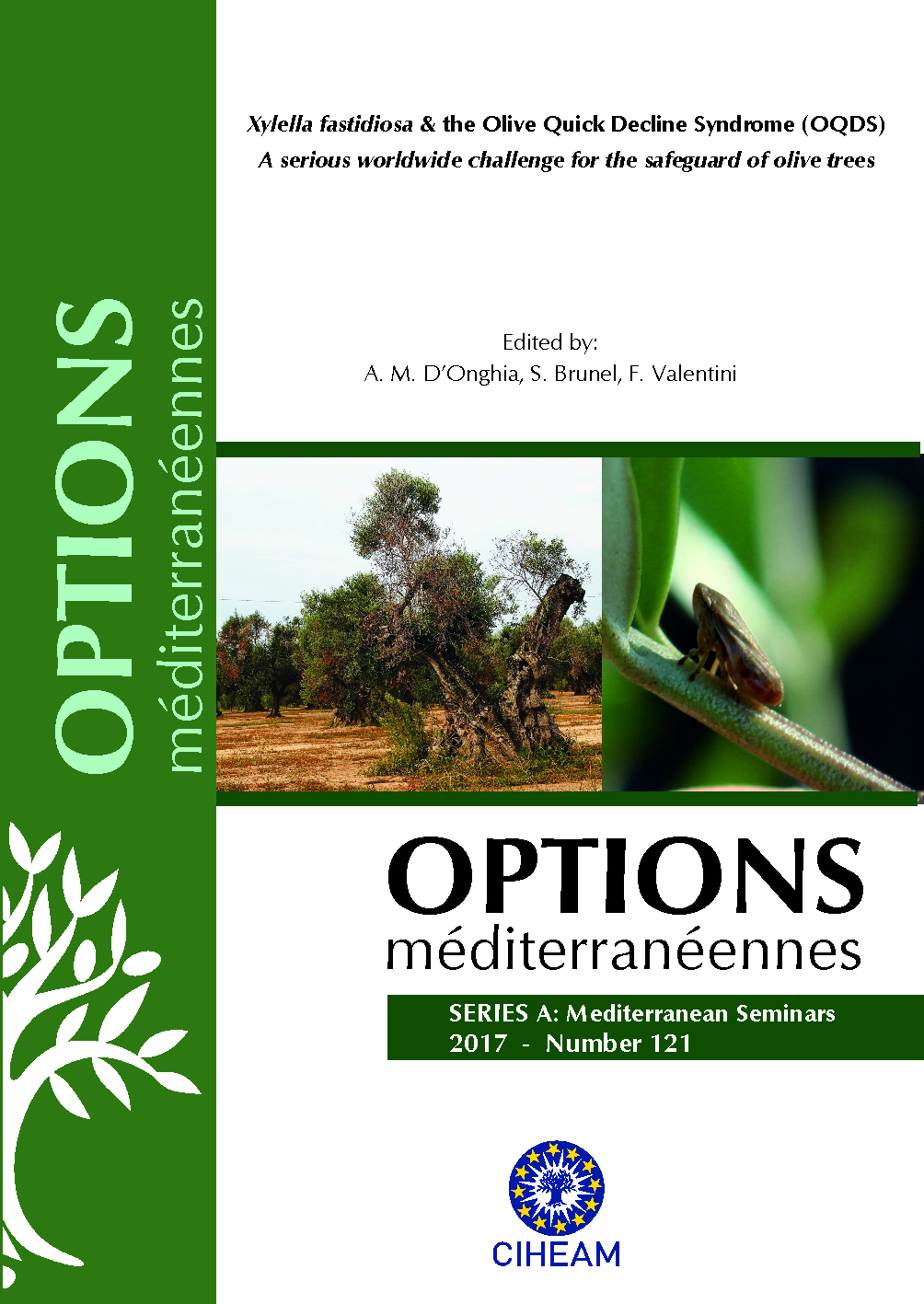CIHEAM actions to combat X. fastidiosa in the Mediterranean region
Lacirignola C., Raeli M.. |
9-10 |

|
|
FAO preventive actions to the introducion and spread of the Olive Quick Decline Syndrome OQDS - associated to Xylella fastidiosa in NENA region
Al-Dobai S., Nasr N.. |
11-12 |

|
|
The International Plant Protection Convention (IPPC) and its standards on pest surveillance and diagnostics to prevent the entry of Xylella fastidiosa
Gonçalves Moreira A., Xia J., Brunel S.. |
13-14 |

|
|
Overview of the activities and projects on Xylella fastidiosa of the International Olive Council (IOC)
Ghedira A., Serafini F.. |
15-17 |

|
|
From science to policy, the contributions of EPPO and Euphresco to the Xylella fastidiosa emergency
Petter F., Baldissera G.. |
19-20 |

|
|
The world threat of Xylella fastidiosa
López M.M., Narco-Noales E., Peñalver J., Morente C., Monterde A.. |
23-24 |

|
|
The olive quick decline syndrome
Martelli G.P., Nigro F.. |
25-28 |

|
|
Xylella fastidiosa and its role in the Olive Quick Decline Syndrome
Saponari M., Boscia D., Martelli G.P.. |
29-30 |

|
|
Main insect vectors of Xylella fastidiosa in Italy and worldwide
Cavalieri V., Porcelli F.. |
31-32 |

|
|
Xylella fastidiosa: the status of the infection and control measures in France
Legendre B., Denancé N., Olivier V., Molusson D., Juteau V., Agud-Miguel D., Sainte-Luce A., Dousset C., Audusseau C., Paillard S., François C., Rivoal C., Germain J.-F., Reynaud P., Jerphanion P. de, Joudar S., Francart J., Poirier A., Lecat M., Poliakoff F., Jacques M.-A.. |
33-35 |

|
|
State of the art of the research on X. fastidiosa in Puglia
Saponari M.. |
37-40 |

|
|
Current EU research initiatives on Xylella fastidiosa
Boscia D., Saponari M.. |
41-42 |

|
|
CIHEAM/IAMB innovative tools for early surveillance and detection of Xylella fastidiosa
D'Onghia A.M.. |
43-46 |

|
|
IT platform based on smart device and web-application for the survey of Xylella fastidiosa
Santoro F., Gualano S., Favia G., D'Onghia A.M.. |
47-48 |

|
|
Sampling procedures of plant material for the survey of Xylella fastidiosa in Puglia Region, Italy
Valentini F., Cavallo G., D'Onghia A.M.. |
49-52 |

|
|
The "Spy Insect" approach for monitoring Xylella fastidiosa in absence of symptomatic plants
Yaseen T., Valentini F., Santoro F., Lorusso D., D'Onghia A.M.. |
53-54 |

|
|
Use of conventional DNA- and protein-based techniques for the detection and characterization of Xylella fastiosa in Italy
Elbeaino T., Digiaro M.. |
55-56 |

|
|
PCR assays for the detection of Xylella fastidiosa. Review and comparison of published protocols
Reisenzein H.. |
57-60 |

|
|
Direct Tissue ImmunoBlot Assay (DTBIA), an effcient tool for the mass detection of Xylella fastidiosa in infected olive trees
Djelouah K., Frasheri D.. |
61-64 |

|
|
Specific, Sensitive, and Rapid Diagnosis of Xylella fastidiosa from olive plant material by a new Loop-Mediated Isothermal Amplification (LAMP) system
Yaseen T., Si Ammor M., Casini G., Drago S., Stampone G., Elbeaino T., Digiaro M.. |
65-66 |

|
|
Organization of ring tests on diagnostic methods among Italian laboratories
Loreti S., Pucci N., Loconsole G., Modesti V., Potere O., Lucchesi S., Gaffuri F., Saponari M.. |
69-70 |

|
|
Transcriptome profiling of two olive cultivars infected by Xylella fastidiosa
Giampetruzzi A., Morelli M., Saponari M., Loconsole G., Chiumenti M., Boscia D., Savino V., Martelli G.P., Saldarelli P.. |
73-76 |

|
|
Preliminary results on field trials to control Xylella fastidiosa on olive trees in Puglia
Scortichini M.. |
77-78 |

|
|
Preliminary results of comparative efficacy evalutation trials against Philaenus spumarius L., vector of Xylella fastidiosa
Dongiovanni C., Cavalieri V., Altamura G., Di Carolo M., Fumarola G., Saponari M., Porcelli F.. |
79-80 |

|
|
Sustainable strategies to contain the Olive Quick Decline Syndrome in southeast Italy
Carlucci A., Ingrosso F., Lops F.. |
81-82 |

|
|
Good agricultural practices in the management of the Olive Quick Decline Syndrome
Xiloyannis C., Mininni A.N., Lardo E., Miccoli A., Fausto C.. |
83-85 |

|
|
Risk assessment of Xylella fastidiosa in the EU territory and other EFSA activities
Winter S., Bragard C., Tramontini S., Andueza M., Stancanelli G.. |
87-89 |

|
|
A Pest Risk Analysis on Xylella fastidiosa for the countries of the Near East Plant Protection Organization, focusing on the olive-infecting strain
Chouibani M., Fawzy A., Al Awad E., Eid P., Akarid N., Shubib S., Barham H., Smith J.. |
91-92 |

|
|
Pest risk analysis on Xylella fastidiosa in Palestine
Shubib S., Hamdan I.. |
93-96 |

|
|
Work done and actions taken on Xylella fastidiosa in Lebanon
Choueiri E.. |
97-100 |

|
|
Regulations enforced against Xylella fastidiosa in Jordan
Meihiar M., Sarhan S.. |
101-102 |

|
|
Regulatory status and phytosanitary measures implemented to face Xylella fastidiosa and its vectors in Egypt
Hammad H., Hanafy S.M.. |
103-104 |

|
|
Xylella fastidiosa in the framework of the EU plant quarantine law
Arijs H.. |
105 |

|
|
EU Legislation on Xylella fastidiosa
Di Rubbio P.. |
107-108 |

|
|
International legal framework for phytosanitary protection: obligations and responsibilities under the IPPC
Bullon C.. |
109-112 |

|
|
Legislative aspects for the mandatory control of Xylella fastidiosa in Puglia and in Italy
Schito S., Percoco A., D'Onghia A.M.. |
113-116 |

|
|
The elements of successful capacity development for Xylella fastidiosa
Brunel S., Sosa O.. |
117-119 |

|
|
The importance of communication on phytosanitary issues. The case of Xylella fastidiosa
Brunel S., D'Onghia A.M.. |
121 |

|
|





